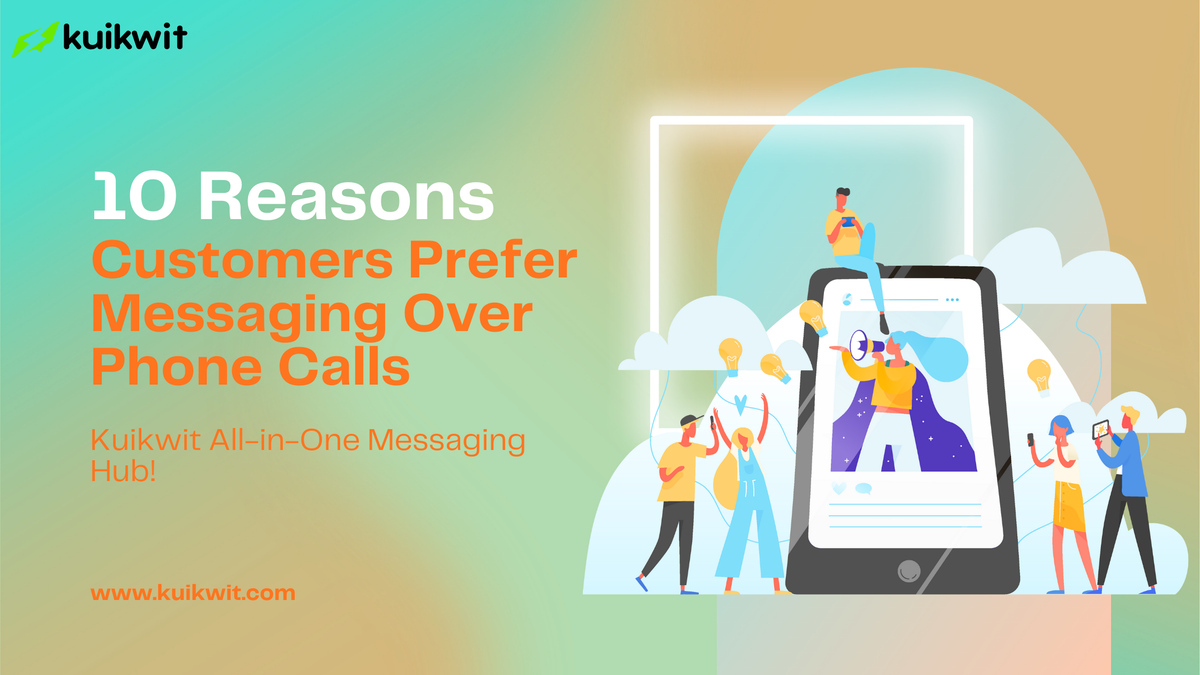10 Reasons Customers Prefer Messaging Over Phone Calls | Faster Customer Support
Discover 10 reasons why customers prefer messaging over phone calls. Learn how messaging boosts convenience, speed, and customer satisfaction with tools like Kuikwit.

Imagine this: Sarah is at work when she realizes there’s a problem with her online order. She wants to contact customer support but doesn’t have time for a long phone call, hold music, or being transferred from one agent to another. Instead, she chooses messaging. Within minutes, she sends a quick text, gets a reply, and resolves her issue all without disrupting her day.
This is the reality of modern customer service. More and more people prefer messaging over phone calls, and businesses that adapt see stronger customer satisfaction, loyalty, and growth. In fact, according to Zendesk’s 2023 Customer Experience Trends Report, 70% of customers now expect conversational experiences across digital channels.
If you’re still relying mostly on phone support, it’s time to understand why messaging is winning. Let’s explore the 10 reasons customers prefer messaging over phone calls and how your business can benefit.
1. Convenience at Any Time
Messaging allows customers to communicate when it suits them whether they’re at work, on the go, or relaxing at home. Unlike phone calls, which demand immediate focus, messages can be sent and answered at a customer’s own pace.
For businesses, this means fewer missed opportunities because customers don’t have to wait until they’re “free” to reach out.
2. No Waiting on Hold
Nobody likes waiting on hold with repetitive music. A study by PH Media Group found that over 60% of customers will hang up after waiting for just one minute. Messaging eliminates this frustration by letting customers send their query instantly and get notified when there’s a response.
3. Multitasking Made Easy
Customers can continue their daily activities while messaging support. Whether they’re cooking, traveling, or working, they don’t have to dedicate full attention to a call. Messaging fits naturally into busy lifestyles, which is one reason it’s become the preferred method.
4. Written Record of Conversations
Unlike phone calls, messaging provides a permanent written record. Customers can revisit past chats to confirm details like order numbers, instructions, or solutions provided. This builds trust and reduces misunderstandings.
5. Faster Response Times with the Right Tools
When businesses use platforms like Kuikwit (your all-in-one messaging hub), they can manage all customer inquiries from social media, email, and live chat in one place. This leads to faster responses and happier customers. A HubSpot study showed that 90% of customers rate an “immediate” response as important, and messaging makes that possible.
6. Personalization and Empathy
Messaging allows for more personalized communication. Using the customer’s name, referencing past purchases, and showing empathy is easier in a conversational tone. Customers feel valued, not rushed through a scripted phone call.
7. Global and Cost-Friendly
For international businesses, phone calls can be costly and inconvenient due to time zones. Messaging bridges that gap. Customers can reach out anytime without worrying about fees or waiting until business hours.
8. Privacy and Comfort
Some customers simply don’t like speaking on the phone especially younger generations. A survey by BankMyCell revealed that 81% of Millennials experience anxiety before making a phone call. Messaging offers a less intimidating, more comfortable alternative.
9. Automation with a Human Touch
Messaging platforms allow businesses to use chatbots for FAQs, order tracking, or appointment booking. But unlike phone menus (“Press 1 for billing, press 2 for support”), messaging automation feels natural and conversational. If escalation is needed, a human agent can take over seamlessly.
10. Builds Long-Term Relationships
Messaging makes customer communication feel like an ongoing relationship rather than a one-time transaction. Customers can pick up where they left off, and businesses can nurture loyalty by checking in or sending helpful updates. This continuity is nearly impossible with traditional phone calls.
Why Businesses Must Adapt
Customers clearly prefer messaging. But the real question is: Are businesses ready to meet that demand?
A report by Twilio shows that 9 out of 10 consumers want to message brands, but less than half of companies are fully equipped to support it. Businesses that make the shift gain a competitive edge with:
- Higher engagement
- Faster resolutions
- Stronger retention rates
- Increased sales opportunities
Tools like Kuikwit make it easy by unifying messages from multiple channels, training teams for consistency, and ensuring no customer gets ignored.
Conclusion
Phone calls once dominated customer service, but the shift is clear messaging is the future. Customers want speed, convenience, comfort, and consistency, and messaging delivers all of that. Businesses that ignore this trend risk losing customers to competitors who are more accessible.
The real question is: Are you ready to give your customers the messaging experience they already prefer?




